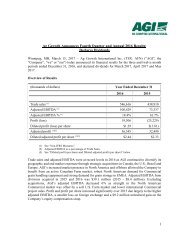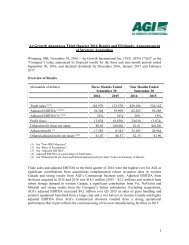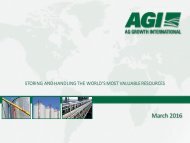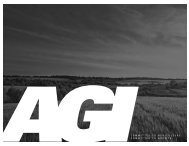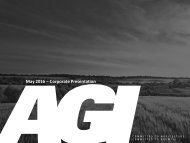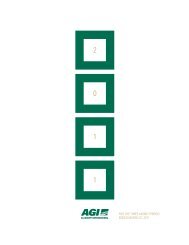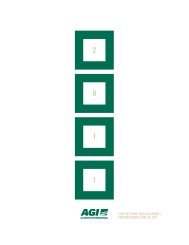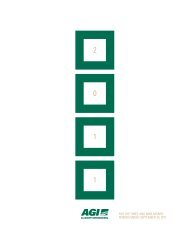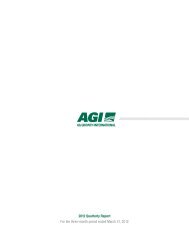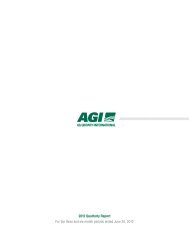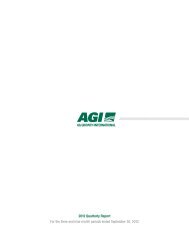2016 Annual Report For Web 7.3MB
You also want an ePaper? Increase the reach of your titles
YUMPU automatically turns print PDFs into web optimized ePapers that Google loves.
exchange rates as at the dates of the initial transaction. Non-monetary<br />
items measured at fair value in a foreign currency are translated using<br />
the exchange rates at the date when the fair value is determined.<br />
The assets and liabilities of foreign operations are translated into<br />
Canadian dollars at the rate of exchange prevailing at the reporting<br />
date and their consolidated statements of income are translated at<br />
the monthly rates of exchange. The exchange differences arising on<br />
the translation are recognized in other comprehensive income. On<br />
disposal of a foreign operation, the component of other comprehensive<br />
income relating to that particular foreign operation is recognized in the<br />
consolidated statements of income.<br />
Any goodwill arising on the acquisition of a foreign operation and any<br />
fair value adjustments to the carrying amounts of assets and liabilities<br />
arising on the acquisition are treated as assets and liabilities of the<br />
foreign operation and translated at the rate of exchange prevailing at<br />
the reporting date.<br />
PROPERTY, PLANT AND EQUIPMENT<br />
Property, plant and equipment are stated at cost, net of any<br />
accumulated depreciation and any impairment losses determined. Cost<br />
includes the purchase price, any costs directly attributable to bringing<br />
the asset to the location and condition necessary and, where relevant,<br />
the present value of all dismantling and removal costs. Where major<br />
components of property, plant and equipment have different useful<br />
lives, the components are recognized and depreciated separately.<br />
AGI recognizes in the carrying amount of an item of property, plant<br />
and equipment the cost of replacing part of such an item when the<br />
cost is incurred and if it is probable that the future economic benefits<br />
embodied with the item can be reliably measured. All other repair and<br />
maintenance costs are recognized in the consolidated statements of<br />
income as an expense when incurred.<br />
Depreciation is calculated on a straight-line basis over the estimated<br />
useful lives of the assets as follows:<br />
Buildings and building components<br />
Manufacturing equipment<br />
Computer hardware<br />
Leasehold improvements<br />
Equipment under finance leases<br />
Furniture and fixtures<br />
Vehicles<br />
20 – 60 years<br />
10 – 20 years<br />
5 years<br />
Over the lease period<br />
10 years<br />
5 – 10 years<br />
4 – 16 years<br />
An item of property, plant and equipment and any significant part<br />
initially recognized is derecognized upon disposal or when no future<br />
economic benefits are expected from its use or disposal. Any gain or<br />
loss arising on derecognition of the asset is included in the consolidated<br />
statements of income when the asset is derecognized.<br />
The assets’ useful lives and methods of depreciation of assets are<br />
reviewed at each financial year-end, and adjusted prospectively, if<br />
appropriate. No depreciation is taken on construction in progress until<br />
the asset is placed in use. Amounts representing direct costs incurred<br />
for major overhauls are capitalized and depreciated over the estimated<br />
useful lives of the different components replaced.<br />
LEASES<br />
The determination of whether an arrangement is, or contains, a lease<br />
is based on whether fulfillment of the arrangement is dependent on the<br />
use of a specific asset or assets or the arrangement conveys a right to<br />
use the asset.<br />
Finance leases, which transfer to AGI substantially all the risks and<br />
benefits incidental to ownership of the leased item, are capitalized at<br />
the commencement of the lease at the fair value of the leased property<br />
or, if lower, at the present value of the minimum lease payments. Lease<br />
payments are apportioned between finance charges and reduction of<br />
the lease liability so as to achieve a constant rate of interest on the<br />
remaining balance of the liability. Finance charges are recognized in<br />
finance costs in the consolidated statements of income.<br />
Leased assets are depreciated over the useful life of the asset.<br />
However, if there is no reasonable certainty that AGI will obtain<br />
ownership by the end of the lease term, the asset is depreciated over<br />
the shorter of the estimated useful life of the asset and the lease term.<br />
Operating lease payments are recognized as an expense in the<br />
consolidated statements of income on a straight-line basis over the<br />
lease term.<br />
BORROWING COSTS<br />
Borrowing costs directly attributable to the acquisition, construction<br />
or production of an asset that necessarily takes a substantial period of<br />
time, which AGI considers to be 12 months or more, to get ready for its<br />
intended use or sale are capitalized as part of the cost of the respective<br />
assets. All other borrowing costs are expensed in the period they occur.<br />
INTANGIBLE ASSETS<br />
Intangible assets acquired separately are measured on initial<br />
recognition at cost. The cost of intangible assets acquired in a business<br />
combination is its fair value at the date of acquisition. Following initial<br />
recognition, intangible assets are carried at cost less any accumulated<br />
amortization and any accumulated impairment losses. The useful lives<br />
of intangible assets are assessed as either finite or indefinite. Intangible<br />
assets with finite useful lives are amortized over the useful economic<br />
life and assessed for impairment whenever there is an indication that<br />
the intangible asset may be impaired. The amortization method and<br />
amortization period of an intangible asset with a finite useful life are<br />
reviewed at least annually. Changes in the expected useful life or the<br />
expected pattern of consumption of future economic benefits embodied<br />
in the asset are accounted for by changing the amortization period<br />
or method, as appropriate, and are treated as changes in accounting<br />
estimates. The amortization expense on intangible assets with finite<br />
lives is recognized in the consolidated statements of income in the<br />
expense category consistent with the function of the intangible assets.<br />
Intangible assets with indefinite useful lives, which include brand<br />
names, are not amortized, but are tested for impairment annually,<br />
either individually or at the CGU level. The assessment of indefinite life<br />
is reviewed annually to determine whether the indefinite life continues<br />
to be supportable. If not, the change in useful life from indefinite to<br />
finite is made on a prospective basis.<br />
Internally generated intangible assets are capitalized when the product<br />
or process is technically and commercially feasible and AGI has<br />
sufficient resources to complete development. The cost of an internally<br />
generated intangible asset comprises all directly attributable costs<br />
necessary to create, produce and prepare the asset to be capable<br />
of operating in the manner intended by management. Expenditures<br />
incurred to develop new demos and prototypes are recorded at cost as<br />
internally generated intangible assets. Amortization of the internally<br />
generated intangible assets begins when the development is complete<br />
and the asset is available for use and it is amortized over the period of<br />
expected future benefit. Amortization is recorded in cost of goods sold.<br />
During the period of development, the asset is tested for impairment at<br />
least annually.<br />
Finite-life intangible assets are amortized on a straight-line basis over<br />
the estimated useful lives of the related assets as follows:<br />
Patents<br />
Distribution networks<br />
Demos and prototypes<br />
Order backlog<br />
Non-compete agreement<br />
Software<br />
4 – 10 years<br />
8 – 25 years<br />
3 – 15 years<br />
3 – 6 months<br />
7 years<br />
5 – 8 years<br />
Gains or losses arising from derecognition of an intangible asset are<br />
measured as the difference between the net disposal proceeds and the<br />
carrying amount of the asset and are recognized in the consolidated<br />
statements of income when the asset is derecognized.<br />
IMPAIRMENT OF NON-FINANCIAL ASSETS<br />
AGI assesses at each reporting date whether there is an indication<br />
that an asset may be impaired. If such an indication exists, or when<br />
annual testing for an asset is required, AGI estimates the asset’s<br />
recoverable amount. The recoverable amount of goodwill as well as<br />
intangible assets not yet available for use is estimated at least annually<br />
on December 31. The recoverable amount is the higher of an asset’s or<br />
CGU group’s fair value less costs to sell and its value in use.<br />
Value in use is determined by discounting estimated future cash<br />
flows using a pre-tax discount rate that reflects the current market<br />
assessment of the time value of money and the specific risks of the<br />
asset. In determining fair value less costs to sell, recent market<br />
77 CONSOLIDATED FINANCIAL STATEMENTS<br />
FIELD TO CONSUMER<br />
<strong>2016</strong> ANNUAL REPORT<br />
CONSOLIDATED FINANCIAL STATEMENTS 78



